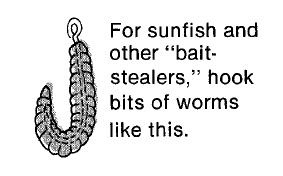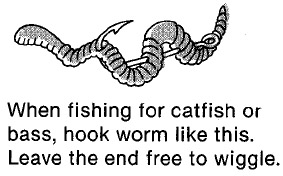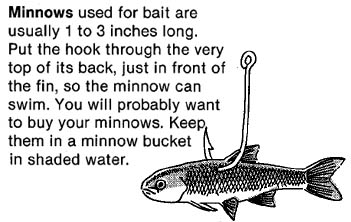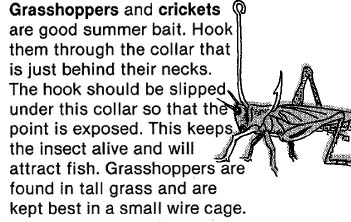 |
|||||||||
Fishing in Carlyle... Lesson 3. Fishing Tools
This lesson requires no help from adults or any tools except your brain!
What should I take on a fishing trip? When it is time to pack your bag for a fishing trip, it can be hard to think of all the extra things you will need. Of course you'll need your fishing pole, bait, hook, bobbers, sinkers and extra fishing line....but what else? Clothes and Other Accessories... Now is not the time to wear perfume or makeup, girls, bugs really like those sweet smells. Carlyle Lake is well-known for having a ton of mosquitoes. You will need some bug spray to protect yourself from these nasty insects. You will also need protection from the sun. Since you are at the water's edge, you have a chance to get sunburnt from two directions! The sun is shining down on you from the sky, and because the water is like a giant mirror it will reflect off of the water and burn you from below. It is very important to wear some strong sunblock. If you are going to be fishing all day, you will need to reapply after a few hours. Did you know you can get sunburnt on the scalp under your hair? It isn't much fun, so wear a hat to protect your head as well. It is also important to have a nice set of sunglasses, otherwise it can be too bright to look at the water. The rest of your clothing depends on the weather and where you are fishing. If you have to hike through tall grass, you will want some long pants and tennis shoes, but if you are walking through a sandy beach, flip flops and shorts might be better. Ask the adult taking you fishing what kind of clothes you should wear. Another good thing to bring is some snacks and a drink or bottle of water for the day. Fishing is hot work, snacks and drinks can help keep you comfortable throughout the day. Leave things like tablets and your Nintendo DS at home. If you drop any electronics in the water, it could ruin them. Fishing Tackle... Fishing tackle is any tool that you need to use when fishing. You will need scissors to trim your line and pliers to set the sinker and help remove the hook from the fish. You can bring these separately or buy a pair of Fishermen's Pliers. These combine the tools so that you don't have to carry them both around. You will need something to hold your fish after you catch them. The proper tool is a Creel. This is the basket pictured to the right. You can set the basket in the water so that you can keep your fish alive and in the water, but contained. Some people just bring coolers or buckets that they fill with water then drain before leaving. It is also pretty handy to have a net with a handle to help you bring the fish in. |
|
||||
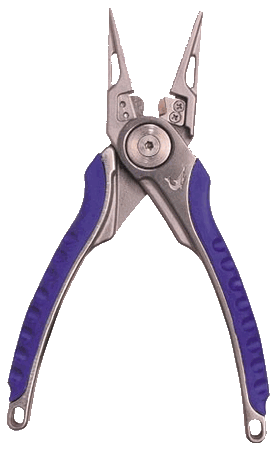 |
|||||
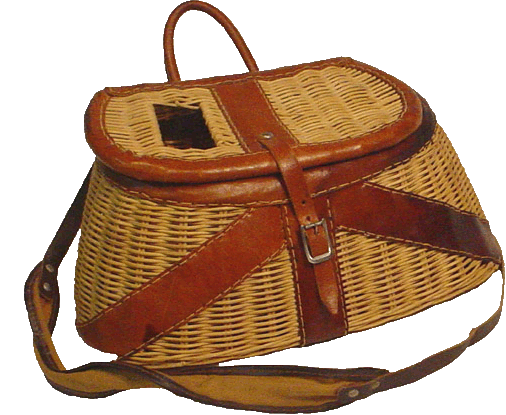 |
|||||
Bait Bait is the thing you put on your hook to catch a fish. The most common type of bait is actually a plain old worm. You can find your own worms, buy them live from bait shops or buy fake worms if you are a little unsure about putting a hook through the worm. Most fish will eat the worms, but they also like things like Minnows or Grasshoppers. It is easiest to just buy these types of bait from the store. Look at the pictures below to see how to hook some of the different types of bait. There are many different types of bait, but as a beginner it is easiest to stick to the basics.
|
|||||
The Fishing Pole Every fisherman needs something to catch the fish with. The type of fishing pole you use will depend on what you have or what you buy. You can find children's fishing poles with characters like Barbie, SpongeBob or Batman on them. These poles will do a decent job and look pretty cool at the same time. Fishing poles are rated by the weight of the fish they can catch. When fishing for Crappie, you will only need a lightweight, 2-6 pound fishing pole. Find one that you like, or use one that you have already, but in the end, your first fishing pole does not need to be something expensive. Let's look at the parts of a fishing pole.
What you see above are the pieces of a fishing pole. It is fairly simple. The best kind of a pole for a kid to start with is a Push Button or Spincaster pole. This means that when you cast, you push the button to start and release it as you fling the line. The reel holds all of your fishing line. This gets fed through the line guides (only one is pictured) and then at the very end the bobber, sinker and hook will be placed or tied onto the line. The handle is what you turn to wind the fishing line back into the reel and hopefully pull the fish you just caught back to you. |
|||||
Line Just like fishing poles, fishing line is sold by the weight it can hold. You should buy the line that works with your pole. If you have a 2-6 pound fishing pole, you should buy 6 pound line. You will want to find fishing line that will match the strength of your pole, or even be a little stronger, so that your line doesn't break as easily. |
 |
||||
Bobbers Bobbers or floats help you keep an eye on your fishing line and tell you if you caught a fish. When a fish gets hooked by your line, they will try to swim away. This pulls the bobber down so that it goes under water a bit. When this happens, you know it is time to reel in your fish! You will want to leave quite a bit of space between your bobber and your sinker if you are fishing in deep water. Carlyle Lake is not that deep, so you won't need to leave that much space, but it does depend on which place in the lake you are fishing from. The adult who is taking you fishing will know how much distance you should leave between the bobber and sinker. |
|||||
Sinkers A sinker is a weight that is attached to your fishing line. Have you ever tried throwing a feather? It is so light that the force of your throw makes it fall to the ground right next to you. This same problem happens when you try to cast fishing line without any weights. The fishing line is so light that it would barely make it to the water even if you were standing at the edge. Another important job that the sinker does, is help anchor the line down in the water so that your bait will be deep enough for the fish to find. If you didn't use it, the hook would stay up towards the surface of the water with the bobber. |
|||||
Hooks The hook is what the bait is put onto so that when the fish bites into your worm, the hook gets caught in their mouth.There are three parts to a hook. There is a loop at the top which is where you tie your line into. This is called the eye of the hook. The shank is the main part of the hook that curves into a 'j' shape. At the very end of the hook is a sharp point and a barb. Once the hook goes into a fish, or your skin if you aren't careful, the barb is what catches on the inside so that the hook doesn't pull out so easily. The barb is why we must be very careful and to have an adult help you if you get stuck with a hook. |
|||||
Watch this video to see how you prepare your fishing pole. |
|||||
| Are you ready for the quiz? | |||||
| Click the link to go to the quiz. There are 10 questions that come from the reading above. When you finish, the quiz will give you three options; "Review Quiz" will take you back through the questions, "Print Results" will open a window with the certificate you need to print to show completion of the lesson and "Finish" will take you to the next lesson. Follow this link to take the quiz now! | |||||
Lesson 1. Fishing Rules | Lesson 2. Fishing Types | Lesson 3. Fishing Tools Lesson 4. Fishing Knots | Lesson 5. Fishing Process | Site Survey |
|||||
Have you finished all three of these lessons? Do you have your certificates printed? If so, you can move on to the next lesson called "How do I Fish?" Click the link at the top or bottom of the page to start the next lessons. If you have already completed the lessons found at both pages, you can take your printed certificates to your Parents, Grandparents, Pack Leader or other Adults to let them know that you are ready to go fishing!

